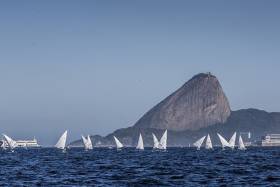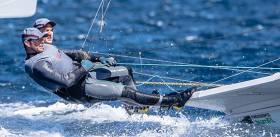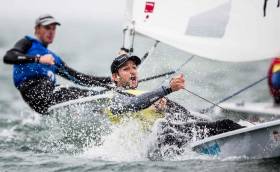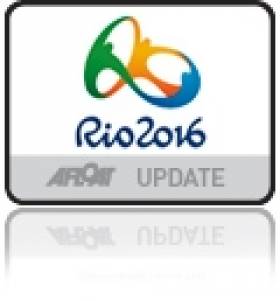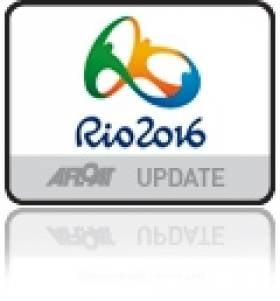Displaying items by tag: Sailing World Cup
National Yacht Club's Lynch Rues 'Big Tactical Mistakes' in Miami, Six Medals For Britain at First Sailing World Cup
Britain's sailors concluded their first World Cup regatta of the 2020 cycle with a six-medal haul as the Sailing World Cup Miami drew to a close on Biscayne Bay on Sunday (29 January) but Irish 49erfx Olympian Saskia Tidey who has switched to campaign for Team GB for Tokyo 2020 was not part of the medal winners. Tidey, from Dun Laoghaire and her new skipper Charlotte Dobson ended up 11th from 16 and overhauled by British rivals Kate MacGregor and Sophie Ainsworth in ninth.
Dun Laoghaire's Finn Lynch, Ireland's sole entry at the first World Cup of 2017, concluded that 'big tactical mistakes in a World Cup fleet don't end well'. The National Yacht Club Laser ace, who became Ireland's youngest ever Olympic helmsman aged 20 in Rio, finished Miami World Cup in 34th position. In the last five races he had four results in top 20 and one race with a yellow flag at the start. The Carlow native says he is 'pretty disappointed' but knows 'for sure my sights can be set a lot higher for the rest of the season'.
Gold for Dylan Fletcher-Stuart Bithell (49er) and a British 1-2 in the Nacra 17 event from Ben Saxton-Nicola Groves and Tom Phipps-Nikki Boniface on Saturday were topped up with two further silver medals and a bronze from Sunday's second day of medal racing.
Lorenzo Chiavarini captured the first British medal of the final day in the Laser class, leapfrogging compatriot and two-time World Champion Nick Thompson to the third step of the podium.
Ben Cornish started the Finn medal race in silver medal position, and had his work cut out defending it during a testing medal race in shifty wind conditions.
In a nail-biting 470 Women's medal race - the final race of the regatta - Sophie Weguelin-Eilidh McIntyre so nearly made it a third gold for the British Sailing Team, but were edged out by Dutch duo Afrodite Zegers-Annaloes van Veen just before the finish.
Top three by class:
470 Women
1. Afrodite Zegers / Anneloes van Veen, NED, 26 points
2. Sophie Weguelin / Eillidh McIntyre, GBR, 29
3. Silva Mas Depares / Paula Barcelo Martin, ESP, 39
470 Men
1. Stuart McNay / David Hughes, USA, 56
2. Tetsuya Isozaki / Akira Takayanagi, JPN, 60
3. Panagiotis Mantis / Pavlos Kagialis, GRE, 68
RS:X Men
1. Louis Giard, FRA, 36
2. Pierre le Coq, FRA, 75
3. Mateo Sanz Lanz, SUI, 78
RS:X Women
1. Yunxiu Lu, CHN, 44
2. Marina Alabau Neira, ESP, 56
3. Manjia Zheng, CHN, 74
Laser
1. Jean Baptiste Bernaz, FRA, 70
2. Pavlos Kontides, CYP, 125
3. Lorenzo Brando Chiavarini, GBR, 134
Laser Radial
1. Vasileia Karachaliou, GRE, 28
2. Evi van Acker, BEL, 46
3. Mathilde de Kerangat, FRA, 69
Finn
1. Jorge Zarif, BRA, 23
2. Ben Cornish, GBR, 51
3. Anders Pedersen, NOR, 55
49er
1. Dylan Fletcher-Scott, GBR, 60
2. Benjamin Bildstein, AUT, 79
3. Diego Botin le Chever, Iago Lopez Marra, ESP, 91
49er FX
1. Martine Soffiatti Grael, BRA, 35
2. Ragna Agerup, NOR, 56
3. Victoria Travascio, ARG, 69
Nacra 17
1. Ben Saxton / Nicola Groves, GBR, 39
2. Tom Phipps / Nicola Boniface, GBR, 50
3. Nico Delle - Karth / Laura Schofegger, AUT, 66
Olympic Sailing Team – Two Months to Improve Before Rio
After a weekend of poor Irish performances at the British round of the Sailing World Cup, the Irish Sailing Association has acknowledged results from Weymouth were 'far from ideal'.
The Sailing World Cup on the Dorset coast, billed as the 'final opportunity for sailors to lay down a marker before the Rio 2016 Olympic Games', was attended by 380 Olympic sailors from 44 nations.
Men’s skiff sailors Ryan Seaton and Matt McGovern from Belfast reached the medal race final which they led for its entirety before sailing the wrong course to the finish line.
London 2012 veteran Annalise Murphy, Ireland’s most successful sailing athlete in the last 30 years, had one of her most disappointing results of the season when she placed 34th in the 39–strong Laser Radial fleet. Murphy has been concentrating on preparations for her second appearance at the games but the Rio venue offers much lighter winds to four years ago when she narrowly missed a podium result.
Andrea Brewster and Saskia Tidey in the women’s skiff placed last in the 49erFX event.
“We have two months to focus on the things we can improve before starting the Olympic regatta in Rio', Team Manager James O'Callaghan said yesterday.
Men’s single-hander Finn Lynch, the youngest ever Irish helm to be selected for Team Ireland did not take part in the regatta due to training-camp commitments in Croatia.
The 49er pair have one further regatta at Kiel Week in Germany later this month before final preparations begin for their second Olympic appearance at Rio 2016 in August.
The first race in the Rio 2016 regatta begins on Monday 8th August when Murphy and Lynch begin their respective events.
A facebook campaign update from the 49er crew:
Sailing World Cup Hyeres Medal Races Live Here
The Finn, Nacra 17, 49er, 49erFX, Men's and Women's RS:X and Laser Radial Medal Races are to follow this afternoon in Hyères, France.
From the French Mistral to a breeze that resembled Rio de Janeiro, Hyères turned things around for the second day of racing at the Sailing World Cup. Ireland's Ryan Seaton and Matt McGovern in the 49er class, are fighting hard for a top ten placing but after six qualification races so far the pair stay 17th overall in a fleet of 40. The Balyholme Yacht Club pair counted 11, 13 and 29 today.
In the women's 49erfx Andrea Brewster and Saskia Tidey are 23 from 24 after four races counting 21 15 (25) OCS, 21
"Sailing in Hyères today was like sailing in Rio,” commented Swedish 49erFX leader Lisa Ericson, sailing with Hanna Klinga, "It's shifty, it's puffy and about having your head out of the boat.”
Rio aside, the famous Mistral that pushed sailors to their limits on Wednesday had completely died down for race day two, resulting in a wait for wind.
A building 8-10 knot breeze came through and racing kicked off just after 13:00 local time resulting in a full complement of completed races.
49er fleet leaders Peter Burling and Blair Tuke (NZL) picked up where they left off from the day prior, sailing consistently at the top of the 49er fleet.
A first, sixth and third helps them to retain their lead over Will and Sam Phillips (AUS) by three points. Jonas Warrer and Christian Peter Lubeck (DEN) are tied for third with John Pink and Stuart Bithell (GBR) on 38 points.
In the Paralympic class, Ireland's Sonar team skippered by John Twomey is eighth from 12.
Meanwhile, team manager James O'Callaghan broke his nose in an accident on board the team RIB.
Sailing World Cup To Be Reviewed
A strategic review of the Sailing World Cup from 2017-2020 is underway in order to ensure that the event series remains the best possible showcase for the sport on the journey to the Tokyo 2020 Olympic Games.
The review will be concluded and proposals presented at the World Sailing mid-year meeting in Lausanne in May 2016.
The comprehensive review will include considering continental representation, calendar and venues, events, sailor quotas, ranking points, Para World Sailing and the role of known and future Olympic venues within the calendar. Sailors will continue to be placed at the heart of the Sailing World Cup, ensuring it is attractive to athletes, commercial partners and the media.
It was agreed that any existing World Sailing contracts with Sailing World Cup Organising Authorities for 2016 would be honoured.
World Sailing Chief Executive, Andy Hunt, and World Sailing President, Carlo Croce, met with Abu Dhabi organisers at the end of February.
Following the World Sailing Executive Committee decision in November 2015 to host the 2016 World Sailing Annual Conference in Europe rather than Abu Dhabi, the Abu Dhabi Tourism Authority took the decision to withdraw their financial support of the 2016 Sailing World Cup Final and future editions of the event.
World Sailing will seek a venue partner for the 2016 Sailing World Cup Final and contractual discussions are ongoing with an alternative venue. World Sailing expect to confirm dates for events in the final quarter of 2016 by the end of March.
ISAF AGM To Hear Portuguese Proposal to Disband Council
As the world governing body for sailing, ISAF, sits down to its annual powwow this week in China it is in the knowledge that it intends sticking to plans to hold races in next year’s Summer Olympics inside highly polluted Guanabara Bay.
But polluted Olympic waters is by no means the only embarrassment on the table for the blazers attending in Sanya.
The fundamental governance structure of ISAF is in question, with a proposal from Portugal to disband Council to be considered at the AGM. The remote and costly nature of this year’s meeting in Sanya has resulted in a smaller than usual turnout of smaller nations who might support this move.
The woes of the Sailing World Cup will also be discussed, with rescue proposals being placed on the agenda by ISAF, who acknowledged that 'the Final is a long way from being a compelling event that attracts top sailors'. In this year’s final two classes were cancelled for lack of entries, one class had only six boats and only two classes attracted the full complement of 20 boats.
Also, the decision by the International Paralympic Committee (IPC to drop sailing from the Paralympic Games programme in 2020 has galvanised ISAF into a rearguard action to prove to the powers that be that sailing merits its place. Afloat.ie will have more on this.
No Irish Racing As Top Sailors Head for ISAF World Cup Final in Dubai
Although Abu Dhabi sets the stage for a fascinating conclusion to the 2015 ISAF Sailing World Cup this week there will unfortunately be no Irish participation among the sport's top athletes heading into four days of intense race competition at the end of a year-round journey towards gold medal glory.
In six of the eight classes which will see action in the UAE capital, defending champions will be aiming to repeat last year's World Cup final success in Abu Dhabi in order to carry another world title towards next year's Olympic Games in Rio de Janeiro.
"There is so much quality here and such a great deal at stake, and we look forward to some very exciting racing," said H.E. Ahmed Thane Al Romaithi, Chairman, Abu Dhabi Sailing and Yacht Club, hosts of the regatta and of today's official press conference, and Vice-President, UAE Sailing & Rowing Federation.
The 2015 ISAF Sailing World Cup Final, which climaxes the prestigious annual series of Olympic sailing for elite and professional sailors, is staged with the additional support of Abu Dhabi Sports Council and Abu Dhabi Tourism & Culture Authority.
Following the official opening ceremony which takes place at 18:30 on Wednesday 28 October at the Abu Dhabi Theatre, Abu Dhabi Sailing and Yacht Club will the next morning launch four days of competition in eight of the ten classes chosen for the 2016 Olympics, as well as kitesurfing.
Among those strongly fancied to strike gold for a second year in Abu Dhabi are the formidable Australian combination of Mat Belcher, the 2014 World Cup gold medallist and 2012 Olympic gold medallist, and Will Ryan, who helped him capture his sixth successive 470 title at the recently concluded World Championships.
No-one enjoyed their gold medal-winning visit to Abu Dhabi more last year than Belgium's Evi Van Acker who returns looking for another Laser Radial triumph.
Meanwhile, Austria's Lara Vadlau and Jolanta Ogar are back to defend their title in the women's 470 class after being pushed all the way last year, while Britain's Bryony Shaw seeks a second successive gold medal in the women's RS:X class.
Britain's Oliver Bridge basically blew away the competition in Abu Dhabi last year to clinch the kiteboard title but can expect a tough title defence over a short track format.
Abu Dhabi Sailing and Yacht Club is staging the final regatta in a series which started in Melbourne, Australia last December before continuing with other qualifying events in Miami, USA, Hyères, France, Weymouth and Portland, Great Britain and finally Qingdao, China last month.
All the race action takes place in the waters around Lulu Island off the Abu Dhabi corniche, presenting a great spectacle for spectators, and a worldwide ISAF television audience of millions.
Sailing enthusiasts are also invited to visit the host club on each day of competition, and on a first come, first served basis, spectator boats will carry enthusiasts out on to the water to present a close-up view of the battle for World Cup success.
More event details can be found here
Sailing World Cup Qualification for 2015 Published By ISAF
#isafswc – The qualification system for the 2015 ISAF Sailing World Cup (SWC) has been published. It will consist of five rounds for all ten Olympic events and where possible, Formula Kite Racing. Download the qualification system as a PDF below.
With reduced quotas, a qualification process based around the ISAF World Sailing Rankings and ISAF Sailing World Cup Qualification Regattas will be used to determine the entrants for each round, ensuring the world's best sailors will be within the World Cup fleets.
Event winners from each SWC Round will qualify to the 2015 SWC Final whilst the best placed 'home continent' sailor in each round will also qualify. The top three finishers at the 2015 Class World Championships (if already held) will qualify to the 2015 SWC Final. The remaining SWC Final places will be awarded via the ISAF World Sailing Rankings.
2015 ISAF Sailing World Cup
Melbourne - 7-14 December 2014
Miami - 25-31 January 2015
Hyères – 20-26 April 2015
Weymouth - 8-14 June 2015
Asian Round – September / October 2015
2015 Final Abu Dhabi – TBC
#swc – Abu Dhabi, United Arab Emirates will host the inaugural 2014 ISAF Sailing World Cup Final through to 2017.
The ISAF Sailing World Cup is the annual circuit of Olympic sailing for elite and professional sailors. Its centre-piece is the ISAF Sailing World Cup Final.
The Final will bring together the top 20 boats in each Olympic event providing them with an annual challenge to compete against the best of the best for the crown of ISAF Sailing World Cup Champion and the ISAF Sailing World Cup prize purse.
The 2014 ISAF Sailing World Cup Final is scheduled for the last week of November 2014.
Carlo Croce, ISAF President, said, "The United Arab Emirates is rich in maritime history and we are delighted that Abu Dhabi will be hosting the ISAF Sailing World Cup Final from 2014 to 2017.
"Over recent years Abu Dhabi has established itself a major hub for hosting international sporting and cultural events. We look forward to working closely with the UAE Sailing and Rowing Federation, the Organising Committee for Abu Dhabi Sailing Events, over the next few months and years."
China, Australia Olympic Teams Dominate ISAF Sailing World Cup Melbourne
#rio – Five Medal Races wrapped up the action at ISAF Sailing World Cup Melbourne with two nations dominating proceedings, Ireland was not represented.
Australia dominated the multihull and skiff fleets whilst China locked out the opposition to take all six podium places in the RS:X.
A strong northerly breeze met athletes at Sandringham Yacht Club for the final day of ISAF Sailing World Cup Melbourne. With gusts over 20 knots there were thrills and spills aplenty on the Stadium course as fans gathered on the Yacht Club balcony to enjoy the spectacle.
Top three by class:
2.4 Metre
1. Paul Francis, NZL
2. Michael Leydon, AUS
3. Matthew Bugg, AUS
470 Men
1.Mathew Belcher / William Ryan
2. Sime Fantela / Igor Marenic, CRO
3. Angus Galloway / Tim Hannah, AUS
470 Women
1. Shasha Chen / Yang Gao, CHN
2. Sasha Ryan / Jaime Ryan, AUS
3. Nan Zhang / Xiao Lv, CHN
49er
1. Nathan Outteridge / Iain Jensen, AUS
2. David Gilmour / Sam Phillips, AUS
3. William Phillips / Rhys Mara, AUS
49erFX
1.Olivia Price / Eliza Solly, AUS
2. Haylee Outteridge / Ella Clark, AUS
3. Ragna Agerup / Maia Agerup, NOR
Finn
1. Bjorn Allansson, SWE
2. Oliver Tweddell, AUS
3. Jake Lilley, AUS
Kiteboarding Men
1. Florian Gruber, GER
2. Riccardo Andrea Leccese, ITA
3. Alejandro Climent Hernandez, ESP
Kiteboarding Women
1. Nuria Goma, ESP
2. Lisa Hickman, AUS
3. Natalie Clarke, AUS
Laser
1. Tom Burton, AUS
2. Thomas Saunders, NZL
3. Matthew Wearn, AUS
Laser Radial
1. Tatiana Drozdovskaya, BLR
2. Dongshuang Zhang, CHN
3. Krystal Weir, AUS
Nacra 17
1.Darren Bundock / Nina Curtis, AUS
2.Euan McNicol / Lucinda Whitty, AUS
3.Jason Waterhouse / Lisa Darmanin, AUS
RS:X Men
1.Chuankun Shi, CHN
2. Chunzhuang Liu, CHN
3. Zhennan Fang, CHN
RS:X Women
1.Manjia Zheng, CHN
2. Qiaoshan Weng, CHN
3. Peina Chen, CHN
SKUD 18
1. Jovin Tan / Desiree Lim, SIN
2. Duncan MacGregor / Liesl Tesch, AUS
3. Amethyst Barnbrook / Brett Pearce





























